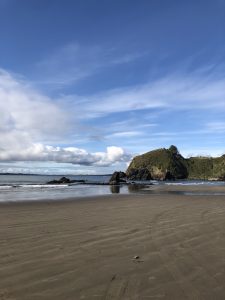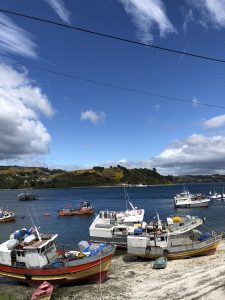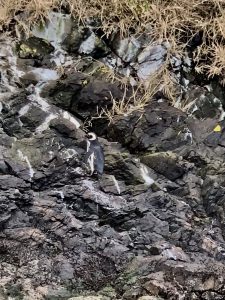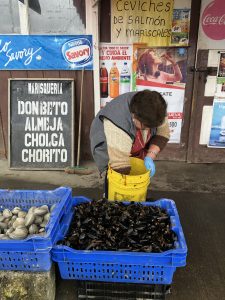Una visita a la isla de Chiloé
Este mes visité la isla grande de Chiloé, una isla en la costa de Chile en el Océano Pacifico. Sus pueblos originarios son los Chonos y los Huilliche (los Mapuche del sur), pero los españoles conquistaron la isla en 1567. Separada del continente debido a la resistencia feroz de los Mapuche, la isla mantenía mucho de su carácter local y su ritmo de vida lento. Por consiguiente, todavía es muy pintoresco y sereno, pero atrae a cada vez más visitantes que son tentados por las más de 150 iglesias y capillas de madera y la oportunidad de ver los palafitos, las casas de madera sobre pilotes que son los hogares tradicionales de los pescadores.

Puñihuil
Para llegar, tomamos un vuelo de Santiago a Puerto Montt, y luego tomamos un bus y un transbordador a la isla. Las vistas que nos acogieron fueron hermosas; ondulantes cerros verdes, la costa escarpada y olas rompiendo en la orilla. El primer día, fuimos a Puñihuil en el norte de la isla y hicimos una navegación para ver a los pingüinos. Chiloé es el único lugar donde los pingüinos Humboldt y Magallanes coexisten, y tuvimos la oportunidad de ver a ambas variedades en las rocas, y además a una cantidad impresionante de delfines que se acercaron al barco.
El taxista nos contó un poco sobre el folclore que caracteriza la isla, que tiene muchos mitos y leyendas. Un ejemplo es el ‘trauco’, una especie de troll que vive en el bosque, y cuyo aliento lo hace irresistible para las mujeres. Por eso, cualquier embarazo inexplicable en la isla es atribuido a él.
También probamos la comida típica de la región, incluyendo un montón de salmón fresco (el mejor que probamos fue preparada frente a nosotros en el mercado de Dalcahue), y el curanto, un plato muy contundente de mariscos, carne, papas y verduras que tradicionalmente se prepara en un hoyo profundo excavado en el suelo tapado con piedras para crear una olla de presión gigante.
Me sorprendió cuánto carácter tenía la isla, y también lo amable y acogedor que era la gente en comparación con Santiago… La naturaleza era espectacular y me sentí completamente revitalizado al regresar a Santiago.

Fishing boats in Dalcahue
ENGLISH:
A visit to Chiloé Island

A penguin in Puñihuil
This month I visited Chiloé island, a large island off the coast of Chile in the Pacific Ocean. It was originally populated by the native Chonos and Huilliche (southern Mapuche) before the Spanish took over the island in 1567. Isolated from the mainland due to the fierce Mapuche resistance, the island maintained a lot of its local character and slow pace of life. As a result, it remains quaint and tranquil, but is starting to attract more visitors who are drawn by the over 150 wooden churches and chapels on the island and the opportunity to see palafitos, timber houses on stilts which are the traditional homes for fishermen.
We visited by flying from Santiago to Puerto Montt, then getting a bus and ferry across to the island. The views we were greeted with from the bus were breath-taking; rolling green hills, craggy coasts and waves crashing on the shore. On the first day we went to Puñihuil in the North of the island and took a boat ride to spot penguins. Chiloé is the only location where the Humboldt and Magallanes penguins cohabit, and we were able to see both perched on the rocks, as well as an incredible number of dolphins that came really close to the boat.
Our taxi driver also introduced us to some of the folklore that characterises Chiloe, which has many myths and legends. An example is the ‘trauco’, a troll that lives in the forest and who’s breath makes him irresistible to women, making him the culprit for any unexplained pregnancies on the island.

Fresh catch in Dalcahue
We also tried some of the local cuisine, including lots of fresh salmon (the best we had was cooked right in front of us by women in the seafront market in Dalcahue) and curanto, an extremely hearty dish of shellfish, meat, potatoes and vegetables that is traditionally cooked in a deep hole dug into the ground and covered with stones to create a giant pressure cooker.
I was struck by how much character the island had, and also by how friendly and warm the people were in comparison to Santiago… The nature was spectacular and I felt thoroughly detoxed coming back to Santiago!
